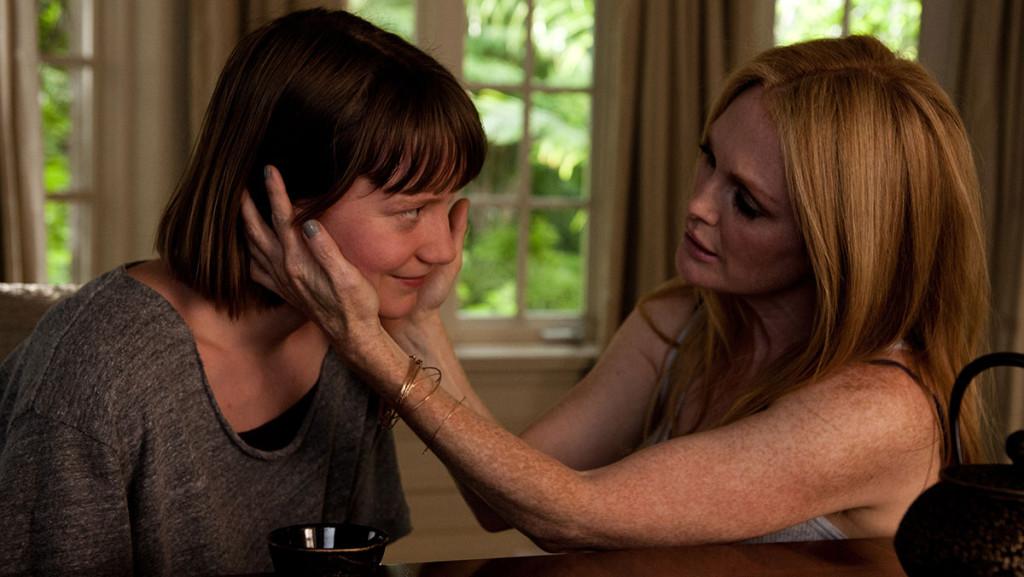A sleeping girl lies beside an empty bus seat. A child star greets a fan on her deathbed. A middle-aged, egotistical actress works with her therapist. “Maps to the Stars” begins with a brief yet misleading look at characters Agatha (Mia Wasikowska), Benjie (Evan Bird) and Havana (Julianne Moore), setting the stage for what appears to be the cliche, tried-and-true look into how fame and greed destroy the human psyche. But this film shatters the viewers’ expectations, delivering a far more philosophical and dense piece than what the audience can anticipate from the opening scenes.
“Maps to the Stars” weaves three seemingly independent storylines with a graceful, yet uncomfortable delivery. Dealing with taboo topics such as incest, rape and schizophrenia, the three protagonists come together on their quest for what they call “liberty,” an escape from the literal ghosts and the pressures of society that haunt them. As Agatha attempts to make a life for herself by moving out to Los Angeles, Benjie goes on to make a sequel to his hit movie, “Bad Babysitter,” and Havana struggles to land the same role her late mother once held.
The characters in this film are nothing short of vile, and viewers will have a difficult time finding a decent trait within them. After the audience learns of Agatha’s fire-related accident, Benjie’s recent escape from rehab and Havana’s sexually abusive mother, the characters’ paths begin to cross, and their interactions with one another move the story forward.
With a plot heavy on character interaction, Director David Cronenberg made the poignant decision to zero in on each character individually as he or she spoke, aside from when the characters were in an agreement or a spiritual connection. The score further amplifies this effect. Music begins to play on an otherwise quiet soundtrack whenever two characters strongly interact in frame. For example, the score reflects the fear instilled within Havana as her mother talks at her.
As the central characters begin to interact, the true uncomfortable nature of the film begins to resonate within the viewer. Agatha, whose backstory is hazy and ambiguous earlier in the film, slowly unravels into what resembles a sociopath. Benjie, haunted by his fan whom he disgraced on her deathbed, spirals into depression and fits of anger as he pieces together his life story. Havana, who seems to be letting fame traumatize her, attempts to channel her mother and escape the abuse she once caused her. Their idea of liberty is acting as the common goal, fueled not by greed or power but by self-actualization.
It’s difficult to pinpoint every minute detail that contributes to the whole of “Maps to the Stars.” With an unsettling atmosphere and intimate scenes with little to no background music to comfort the audience, viewers are compelled to swallow hard during certain scenes, almost begging for them to be over — begging for the end, only to crave more. It’s these graphic and stomach-churning scenes that add depth and more accurate insight into the minds of the protagonists. While such uncomfortable scenes will not be to every viewer’s taste, they cater to a specific audience that can digest the risks Cronenberg decided to take.
Disturbing and hard-hitting, “Maps to the Stars” captures the true hardships of reaching personal liberty through the stories of three wealthy and troubled individuals. “Maps to the Stars” is raw with emotions and doesn’t hold back when it comes to sensitive topics. Steering away from the idea that fame and greed warps individuals, this film offers a new perspective on what it means to achieve personal freedom. The final shot as the camera zooms out is nothing but an innocent image on the surface. What lays beneath the shot is far deeper and far more disquieting, leaving viewers to contemplate the film and slowly chip away at its meaning.




















